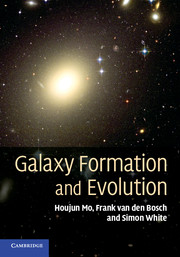Book contents
- Frontmatter
- Contents
- Preface
- 1 Introduction
- 2 Observational Facts
- 3 Cosmological Background
- 4 Cosmological Perturbations
- 5 Gravitational Collapse and Collisionless Dynamics
- 6 Probing the Cosmic Density Field
- 7 Formation and Structure of Dark Matter Halos
- 8 Formation and Evolution of Gaseous Halos
- 9 Star Formation in Galaxies
- 10 Stellar Populations and Chemical Evolution
- 11 Disk Galaxies
- 12 Galaxy Interactions and Transformations
- 13 Elliptical Galaxies
- 14 Active Galaxies
- 15 Statistical Properties of the Galaxy Population
- 16 The Intergalactic Medium
- A Basics of General Relativity
- B Gas and Radiative Processes
- C Numerical Simulations
- D Frequently Used Abbreviations
- E Useful Numbers
- References
- Index
Preface
Published online by Cambridge University Press: 05 June 2012
- Frontmatter
- Contents
- Preface
- 1 Introduction
- 2 Observational Facts
- 3 Cosmological Background
- 4 Cosmological Perturbations
- 5 Gravitational Collapse and Collisionless Dynamics
- 6 Probing the Cosmic Density Field
- 7 Formation and Structure of Dark Matter Halos
- 8 Formation and Evolution of Gaseous Halos
- 9 Star Formation in Galaxies
- 10 Stellar Populations and Chemical Evolution
- 11 Disk Galaxies
- 12 Galaxy Interactions and Transformations
- 13 Elliptical Galaxies
- 14 Active Galaxies
- 15 Statistical Properties of the Galaxy Population
- 16 The Intergalactic Medium
- A Basics of General Relativity
- B Gas and Radiative Processes
- C Numerical Simulations
- D Frequently Used Abbreviations
- E Useful Numbers
- References
- Index
Summary
The vast ocean of space is full of starry islands called galaxies. These objects, extraordinarily beautiful and diverse in their own right, not only are the localities within which stars form and evolve, but also act as the lighthouses that allow us to explore our Universe over cosmological scales. Understanding the majesty and variety of galaxies in a cosmological context is therefore an important, yet daunting task. Particularly mind-boggling is the fact that, in the current paradigm, galaxies only represent the tip of the iceberg in a Universe dominated by some unknown ‘dark matter’ and an even more elusive form of ‘dark energy’. How do galaxies come into existence in this dark Universe, and how do they evolve? What is the relation of galaxies to the dark components? What shapes the properties of different galaxies?
How are different properties of galaxies correlated with each other and what physics underlies these correlations? How do stars form and evolve in different galaxies? The quest for the answers to these questions, among others, constitutes an important part of modern cosmology, the study of the structure and evolution of the Universe as a whole, and drives the active and rapidly evolving research field of extragalactic astronomy and astrophysics.
The aim of this book is to provide a self-contained description of the physical processes and the astronomical observations which underlie our present understanding of the formation and evolution of galaxies in a Universe dominated by dark matter and dark energy.
- Type
- Chapter
- Information
- Galaxy Formation and Evolution , pp. xvii - xxPublisher: Cambridge University PressPrint publication year: 2010

